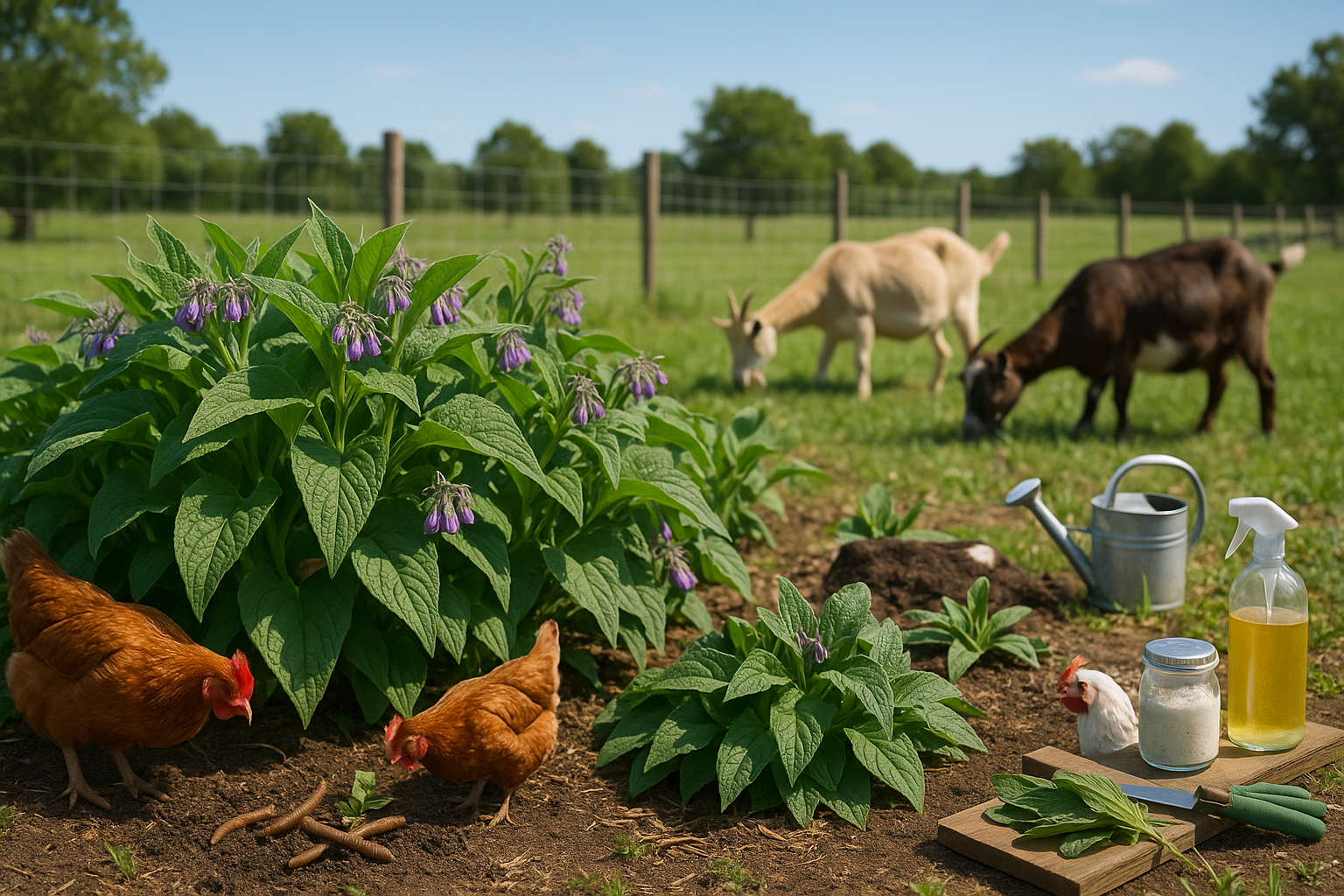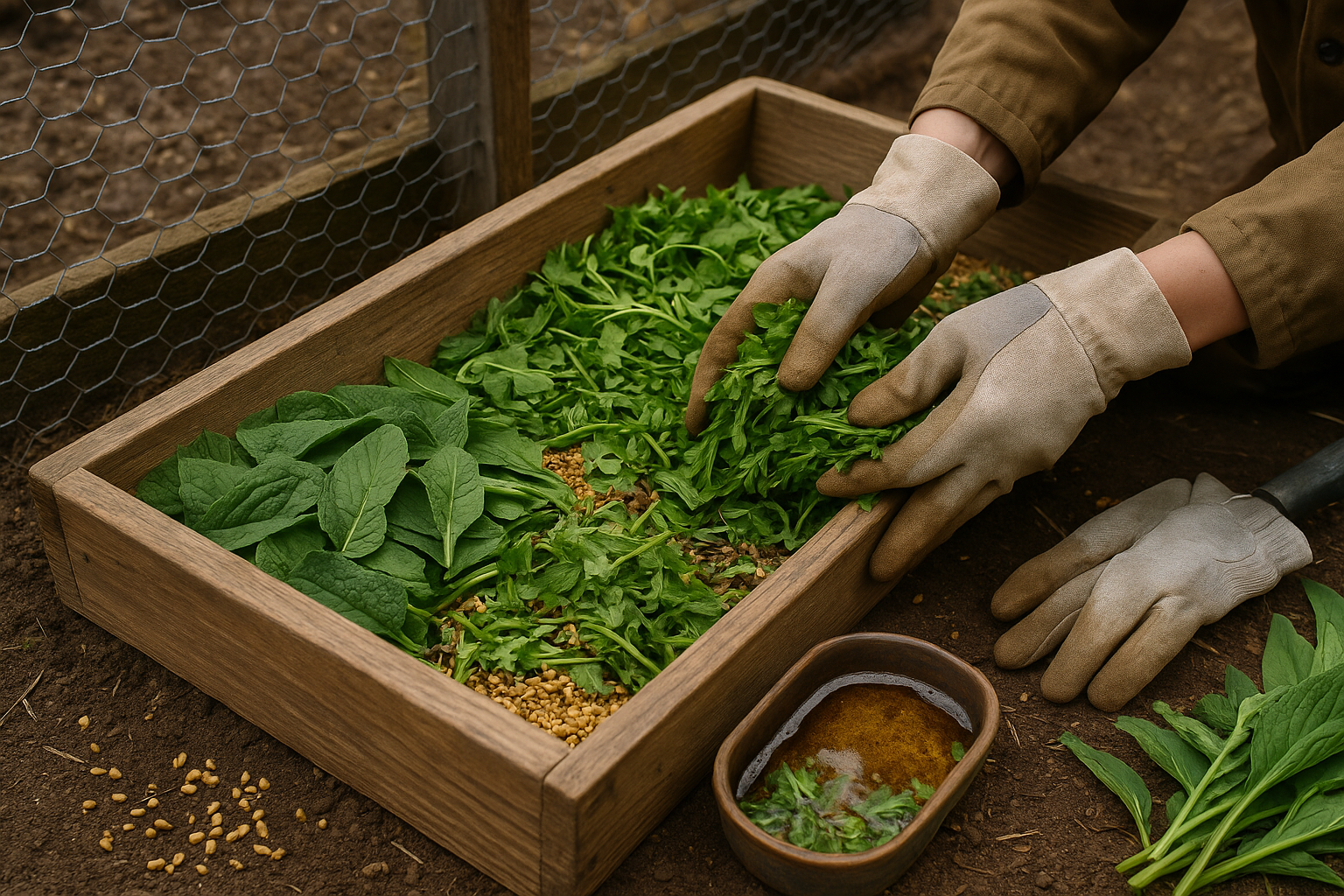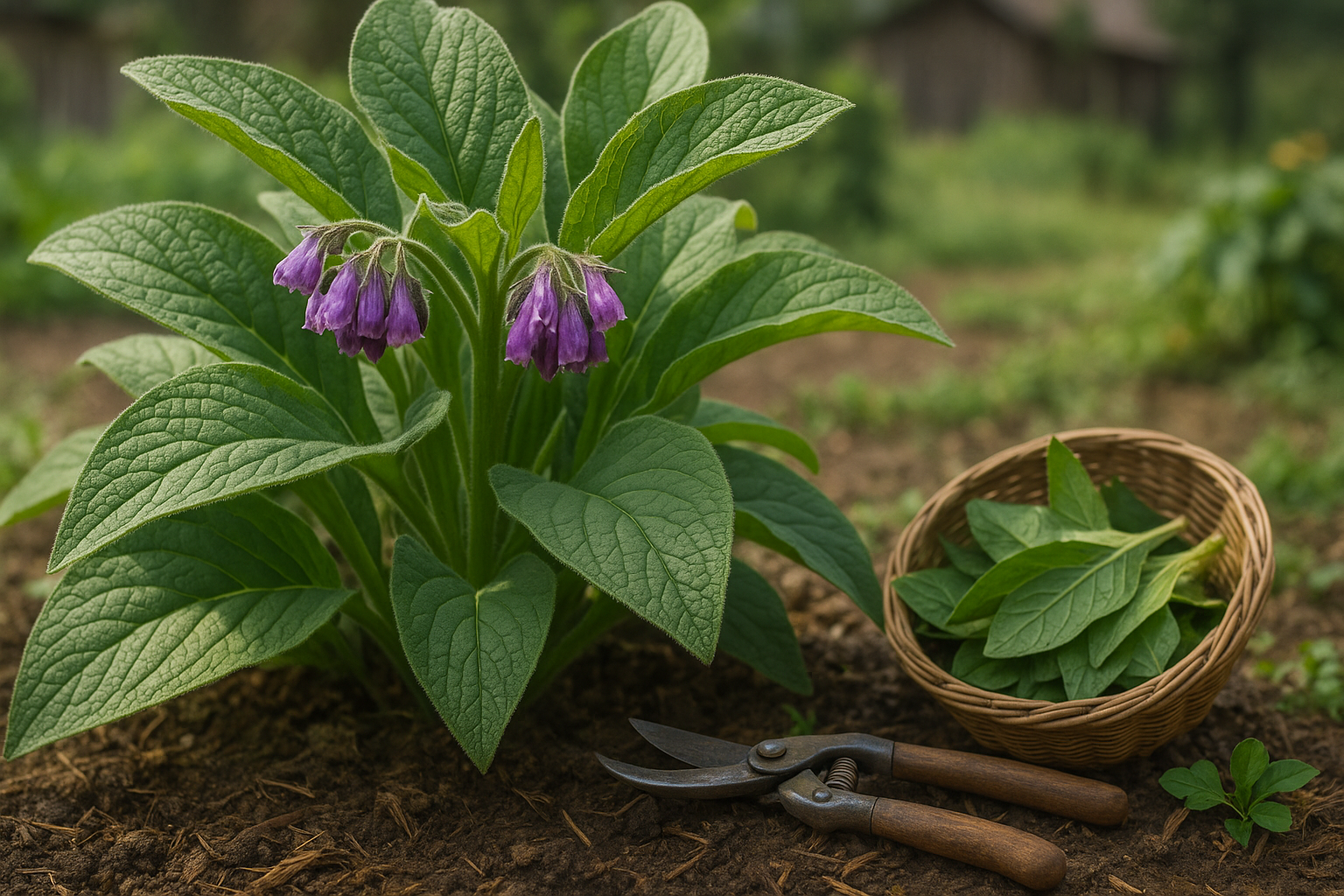Introduction
If you’ve ever wondered, “Is comfrey safe for chickens?” you’re not alone. Comfrey, a leafy perennial herb, is often praised for its fast growth and high nutrient content, making it a popular choice in animal feed and home gardens. However, when it comes to feeding comfrey to chickens or other animals, opinions are divided.
Some backyard flock owners and herbal enthusiasts swear by its health benefits, using it as a protein-rich supplement. Others raise concerns about potential toxins and long-term safety. Navigating these conflicting views can be tricky, especially when your flock’s health is at stake.
In this post, we’ll break down the nutritional advantages of comfrey, discuss the key risks noted by experts, and share practical, real-world advice for anyone considering adding comfrey to their chickens’ or other animals’ diets. Let’s clear up the confusion and help you make informed decisions for your animals.
What is Comfrey and Why Do People Feed It to Animals?

Comfrey is a leafy, hardy perennial herb known for its deep green, fuzzy leaves and clusters of purple, white, or pink bell-shaped flowers. Among the most common varieties are Russian comfrey (Symphytum x uplandicum), prized for its high yield and low seed production, and common comfrey (Symphytum officinale), which tends to spread more readily through self-seeding.
Farmers and homesteaders have used comfrey for centuries both as a natural fertilizer and as animal fodder thanks to its incredible resilience and fast regrowth, often harvesting up to four or five times per season. What sets comfrey apart is its impressive nutritional profile: it contains high levels of protein—sometimes as much as 20–30% on a dry matter basis—as well as abundant potassium, calcium, and iron.
This makes comfrey a favorite for supplementing the diets of livestock, especially chickens, pigs, goats, rabbits, and geese. For example, many chicken keepers chop fresh comfrey leaves and mix them into daily feed, finding that it helps boost egg production and overall health. Pig farmers often allow their animals to graze in comfrey patches or offer cut leaves as a protein-rich treat. Similarly, geese and rabbits enjoy comfrey’s tender leaves, benefiting from its minerals and fiber.
While comfrey shouldn’t be the sole source of nutrition due to compounds called pyrrolizidine alkaloids, it remains a highly valued addition to diverse, natural feeding systems—especially for those seeking affordable and sustainable farm inputs.
Nutritional Benefits of Comfrey for Chickens and Livestock
Comfrey stands out as a powerhouse of nutrition for chickens and livestock, making it a favorite among small-scale farmers and backyard flock owners. This leafy green is known for its high protein content, often ranging from 20% to 30% in young leaves—comparable to quality alfalfa and much higher than traditional pasture grasses.
Beyond protein, comfrey is packed with essential vitamins like A, B12, and C, which support strong immune systems and healthy growth in animals. It is also rich in minerals, particularly calcium, potassium, and manganese, all vital for laying hens and growing livestock. Unlike many other forage crops, comfrey is low in indigestible fiber, allowing animals to utilize more of its nutrients.
Farmers appreciate comfrey because it grows rapidly, can be harvested several times a season, and thrives in a variety of soil conditions—making it a reliable supplement when other greens are scarce. Compared to commercial feeds, comfrey offers a natural, homegrown alternative with fewer additives and a lower carbon footprint.
Many backyard flock keepers use comfrey as a protein boost during the laying season, while goat and sheep owners value its palatability and mineral content as a supplement to hay or grass. Although it shouldn’t fully replace a balanced diet, including comfrey as part of a broader feeding strategy can improve overall flock health, reduce feed costs, and provide peace of mind for those seeking more sustainable, natural livestock nutrition.
Potential Health Risks and Toxicity Concerns
Comfrey contains compounds called pyrrolizidine alkaloids (PAs), which are especially concentrated in its roots. These PAs are known to cause liver damage in both humans and animals, as they are metabolized into toxic substances in the liver. The risk is significant because PAs can accumulate with repeated exposure, even at low levels, and symptoms may not appear until serious damage has occurred.
In chickens, current research suggests they are less sensitive to comfrey’s toxins compared to mammals; however, the long-term effects remain poorly studied, and some poultry experts still recommend caution. For dogs, cattle, horses, and other livestock, comfrey poses greater risks. Ingestion has been linked to symptoms such as loss of appetite, weight loss, jaundice, lethargy, and in severe cases, liver failure or death. For example, some farms have reported livestock deaths after animals grazed on comfrey-rich pastures for several days.
Due to these risks, authorities like the U.S. Food and Drug Administration and the European Medicines Agency advise against internal consumption of comfrey, especially roots and root-based products, by people or animals. While topical use is sometimes permitted, it should be approached with caution since PAs can be absorbed through the skin.
If you keep backyard chickens, limit their exposure to comfrey or feed only small amounts of leaves, avoiding roots entirely. For pets and livestock, it’s safest to exclude comfrey from their diet to prevent accidental poisoning and long-term health issues. Always consult a veterinarian or animal nutritionist before introducing any new forage or supplement, especially one with known toxicity concerns like comfrey.
Safe Ways to Feed Comfrey to Chickens and Animals

When feeding comfrey to chickens and other animals, safety starts with selecting the right plant parts—opt for young, tender leaves rather than roots or older leaves, as these contain fewer alkaloids that can be harmful in large amounts. Always harvest comfrey from chemical-free areas, rinse the leaves thoroughly, and chop them for easy mixing into feed.
Moderation is key: most experts recommend offering comfrey as a supplement, not a staple. Mix it with other greens or forage crops to maintain a balanced diet and avoid overconsumption. Young chicks, pregnant animals, or those with compromised health are more sensitive, so limit comfrey or avoid it entirely for these groups. Robust, mature birds or livestock can handle an occasional handful mixed into their routine foraging.
Rotating comfrey with options like clover, grass, or vegetable scraps helps prevent both nutritional imbalances and palatability issues. Studies, such as those by the Rodale Institute and trials with small-scale farmers, have shown that comfrey can boost egg production and support animal health when used prudently.
However, there’s still debate about long-term risks, so treat comfrey as an occasional treat rather than a daily feed. By closely observing your animals’ health and behavior, and integrating comfrey with a variety of other safe, nutrient-rich forages, you can safely harness its high protein and vitamin content without risking adverse effects.
Veterinary Perspectives and Real-World Experiences
Veterinarians generally urge caution when it comes to feeding comfrey to pets and livestock, primarily due to concerns about its pyrrolizidine alkaloids, which can be toxic to the liver with long-term or high-quantity exposure. Many reputable animal health resources, such as the ASPCA and the FDA, specifically warn against using comfrey as regular feed for animals, especially horses, cattle, and dogs. These organizations emphasize that while comfrey leaves contain some nutrients and can be used medicinally in controlled ways, the risks of toxicity often outweigh any potential benefits.
On the ground, however, small farmers and backyard chicken keepers report mixed experiences. In online forums and Facebook groups, some poultry keepers share that adding a few comfrey leaves to their chickens’ diet caused no noticeable ill effects, even praising its quick regrowth and extra greens during lean months. Goat owners occasionally mention using it sparingly as supplemental forage, but most stress moderation and never making it a staple. A few farmers have shared cautionary tales of digestive upset or animals being reluctant to eat comfrey at all.
The prevailing wisdom in these communities is to offer comfrey only in small quantities, if at all, and to always observe animals for any changes in appetite or behavior. Ultimately, the consensus between veterinary professionals and experienced animal caretakers is clear: while comfrey can be grown on a homestead, its use as animal feed should be limited, closely monitored, and approached with caution.
Practical Tips and Safer Alternatives
If you want to grow comfrey around chickens or livestock, make sure to do it safely by following a few smart practices. Always plant comfrey in a fenced-off area out of reach of animals unless you’re intentionally feeding it in controlled amounts—too much can be harmful if ingested regularly. Choose a spot with partial sun and rich, moist soil, spacing plants well so they don’t take over other pasture forage.
Wear gloves when handling comfrey, as its rough leaves can irritate the skin. Always provide plenty of clean water and other forages to reduce the animals’ reliance on one plant. Rotate foraging spots, and limit the time animals have access to comfrey, especially young chicks or pregnant livestock.
Some farmers prefer to cut comfrey and add it to feed in small amounts as a supplement rather than letting animals graze on it freely. If you’d rather avoid comfrey, tried-and-true alternatives like clover, alfalfa, dandelion greens, plantain, and chicory provide nutritious greens without the same risks.
These forage plants are generally safe and offer a diverse range of nutrients, supporting animal health and pasture diversity. By fencing, managing location, feeding responsibly, and mixing in other greens, you can enjoy comfrey’s benefits with fewer worries, or simply stick to safer leafy options tailored for your flock or herd’s unique needs.
Conclusion
Comfrey provides valuable nutrients for animals, including vitamins, minerals, and protein. However, it also contains compounds like pyrrolizidine alkaloids that can harm the liver if consumed in excess. Because of these benefits and risks, using comfrey as a feed supplement requires caution and informed decision-making.
Always consult a qualified veterinarian before adding new herbs to your animal’s diet. Start with small amounts and carefully monitor for any negative reactions. Keeping a close watch helps ensure your animals stay healthy and allows you to spot problems early, so you can adjust the diet or remove comfrey if issues arise.
